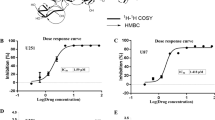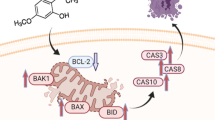Abstract
Natural phytochemicals are attracting increasing interest as anticancer agents. The aim of this study is to evaluate the therapeutic potential of geraniin, a major ellagitannin extracted from Geranium sibiricum L., in human glioma. Human U87 and LN229 glioma cells were treated with different concentrations of geraniin, and cell viability, apoptosis, and gene expression were assessed. The involvement of STAT3 signaling in the action of geraniin was examined. We found that geraniin treatment for 48 h significantly (P < 0.05) impaired the phosphorylation of STAT3 and reduced the expression of downstream target genes Bcl-xL, Mcl-1, Bcl-2, and cyclin D1. Exposure to geraniin led to a concentration-dependent decline in cell viability and increase in apoptosis in glioma cells, but had no significant impact on the viability of normal human astrocytes. Measurement of caspase-3 activity showed that geraniin-treated U87 and LN229 cells showed a 1.8–2.5-fold higher caspase-3 activity than control cells. Overexpression of constitutively active STAT3 significantly (P < 0.05) reversed geraniin-mediated growth suppression and apoptosis, which was accompanied by restoration of Bcl-xL, Mcl-1, Bcl-2, and cyclin D1 expression. In an xenograft tumor mouse model, geraniin treatment significantly retarded tumor growth and induced apoptosis. Western blot analysis confirmed the suppression of STAT3 phosphorylation in glioma xenograft tumors by geraniin. Taken together, these data suggest that geraniin exerts growth-suppressive and pro-apoptotic effects on glioma cells via inhibition of STAT3 signaling and may have therapeutic benefits in malignant gliomas.




Similar content being viewed by others
References
Adams LS, Seeram NP, Aggarwal BB, Takada Y, Sand D, Heber D (2006) Pomegranate juice, total pomegranate ellagitannins, and punicalagin suppress inflammatory cell signaling in colon cancer cells. J Agric Food Chem 54:980–985
Alexiou GA, Tsamis KI, Kyritsis AP (2015) Targeting tumor necrosis factor-related apoptosis-inducing ligand (TRAIL): a promising therapeutic strategy in gliomas. Semin Pediatr Neurol 22:35–39
Bing SJ, Ha D, Kim MJ, Park E, Ahn G, Kim DS, Ko RK, Park JW, Lee NH, Jee Y (2013) Geraniin down regulates gamma radiation-induced apoptosis by suppressing DNA damage. Food Chem Toxicol 57:147–153
Chai EZ, Shanmugam MK, Arfuso F, Dharmarajan A, Wang C, Kumar AP, Samy RP, Lim LH, Wang L, Goh BC, Ahn KS, Hui KM, Sethi G (2016) Targeting transcription factor STAT3 for cancer prevention and therapy. Pharmacol Ther 162:86–97
Chinot OL, Wick W, Mason W, Henriksson R, Saran F, Nishikawa R, Carpentier AF, Hoang-Xuan K, Kavan P, Cernea D, Brandes AA, Hilton M, Abrey L, Cloughesy T (2014) Bevacizumab plus radiotherapy-temozolomide for newly diagnosed glioblastoma. N Engl J Med 370:709–722
Elendran S, Wang LW, Prankerd R, Palanisamy UD (2015) The physicochemical properties of geraniin, a potential antihyperglycemic agent. Pharm Biol 53:1719–1726
Gray GK, McFarland BC, Nozell SE, Benveniste EN (2014) NF-κB and STAT3 in glioblastoma: therapeutic targets coming of age. Expert Rev Neurother 14:1293–1306
Harmalkar M, Upraity S, Kazi S, Shirsat NV (2015) Tamoxifen-induced cell death of malignant glioma cells is brought about by oxidative-stress-mediated alterations in the expression of BCL2 family members and is enhanced on miR-21 Inhibition. J Mol Neurosci 57:197–202
Heber D (2008) Multitargeted therapy of cancer by ellagitannins. Cancer Lett 269:262–268
Ismail T, Calcabrini C, Diaz AR, Fimognari C, Turrini E, Catanzaro E, Akhtar S, Sestili P (2016) Ellagitannins in cancer chemoprevention and therapy. Toxins (Basel) 8(5):E151
Kang KA, Lee IK, Zhang R, Piao MJ, Kim KC, Kim SY, Shin T, Kim BJ, Lee NH, Hyun JW (2011) Radioprotective effect of geraniin via the inhibition of apoptosis triggered by γ-radiation-induced oxidative stress. Cell Biol Toxicol 27:83–94
Karpel-Massler G, Ba M, Shu C, Halatsch ME, Westhoff MA, Bruce JN, Canoll P, Siegelin MD (2015) TIC10/ONC201 synergizes with Bcl-2/Bcl-xL inhibition in glioblastoma by suppression of Mcl-1 and its binding partners in vitro and in vivo. Oncotarget 6:36456–36471
Lee JC, Tsai CY, Kao JY, Kao MC, Tsai SC, Chang CS, Huang LJ, Kuo SC, Lin JK, Way TD (2008) Geraniin-mediated apoptosis by cleavage of focal adhesion kinase through up-regulation of Fas ligand expression in human melanoma cells. Mol Nutr Food Res 52:655–663
Li J, Wang S, Yin J, Pan L (2013) Geraniin induces apoptotic cell death in human lung adenocarcinoma A549 cells in vitro and in vivo. Can J Physiol Pharmacol 91:1016–1024
Ma JW, Zhang Y, Li R, Ye JC, Li HY, Zhang YK, Ma ZL, Li JY, Zhong XY, Yang X (2015) Tetrandrine suppresses human glioma growth by inhibiting cell survival, proliferation and tumour angiogenesis through attenuating STAT3 phosphorylation. Eur J Pharmacol 764:228–239
Mukthavaram R, Ouyang X, Saklecha R, Jiang P, Nomura N, Pingle SC, Guo F, Makale M, Kesari S (2015) Effect of the JAK2/STAT3 inhibitor SAR317461 on human glioblastoma tumorspheres. J Transl Med 13:269
Omuro A, DeAngelis LM (2013) Glioblastoma and other malignant gliomas: a clinical review. JAMA 310:1842–1850
Tanase CP, Enciu AM, Mihai S, Neagu AI, Calenic B, Cruceru ML (2013) Anti-cancer therapies in high grade gliomas. Curr Proteom 10:246–260
Wang J, Wang Q, Cui Y, Liu ZY, Zhao W, Wang CL, Dong Y, Hou L, Hu G, Luo C, Chen J, Lu Y (2012) Knockdown of cyclin D1 inhibits proliferation, induces apoptosis, and attenuates the invasive capacity of human glioblastoma cells. J Neurooncol 106:473–484
Wang SG, Huang MH, Li JH, Lai FI, Lee HM, Hsu YN (2013) Punicalagin induces apoptotic and autophagic cell death in human U87MG glioma cells. Acta Pharmacol Sin 34:1411–1419
Wang Y, Ma J, Chow SC, Li CH, Xiao Z, Feng R, Fu J, Chen Y (2014) A potential antitumor ellagitannin, davidiin, inhibited hepatocellular tumor growth by targeting EZH2. Tumour Biol 35:205–212
Wang P, Qiao Q, Li J, Wang W, Yao LP, Fu YJ (2016) Inhibitory effects of geraniin on LPS-induced inflammation via regulating NF-κB and Nrf2 pathways in RAW 264.7 cells. Chem Biol Interact 253:134–142
Wen PY, Kesari S (2008) Malignant gliomas in adults. N Engl J Med 359:492–507
Xu Z, Zeng X, Tian D, Xu H, Cai Q, Wang J, Chen Q (2014) MicroRNA-383 inhibits anchorage-independent growth and induces cell cycle arrest of glioma cells by targeting CCND1. Biochem Biophys Res Commun 453:833–838
Xue J, Zhou A, Wu Y, Morris SA, Lin K, Amin S, Verhaak R, Fuller G, Xie K, Heimberger AB, Huang S (2016) miR-182-5p induced by STAT3 activation promotes glioma tumorigenesis. Cancer Res 76:4293–4304
Yeh JE, Frank DA (2016) STAT3-interacting proteins as modulators of transcription factor function: implications to targeted cancer therapy. Chem Med Chem 11:795–801
Yue P, Lopez-Tapia F, Paladino D, Li Y, Chen CH, Namanja AT, Hilliard T, Chen Y, Tius MA, Turkson J (2016) Hydroxamic acid and benzoic acid-based STAT3 inhibitors suppress human glioma and breast cancer phenotypes in vitro and in vivo. Cancer Res 76:652–663
Zahin M, Ahmad I, Gupta RC, Aqil F (2014) Punicalagin and ellagic acid demonstrate antimutagenic activity and inhibition of benzo[a]pyrene induced DNA adducts. Biomed Res Int 2014:467465
Zhai JW, Gao C, Ma WD, Wang W, Yao LP, Xia XX, Luo M, Zu YG, Fu YJ (2016) Geraniin induces apoptosis of human breast cancer cells MCF-7 via ROS-mediated stimulation of p38 MAPK. Toxicol Mech Methods 26:311–318
Author information
Authors and Affiliations
Corresponding author
Rights and permissions
About this article
Cite this article
Ren, Z., Zou, W., Cui, J. et al. Geraniin suppresses tumor cell growth and triggers apoptosis in human glioma via inhibition of STAT3 signaling. Cytotechnology 69, 765–773 (2017). https://doi.org/10.1007/s10616-017-0085-4
Received:
Accepted:
Published:
Issue Date:
DOI: https://doi.org/10.1007/s10616-017-0085-4




